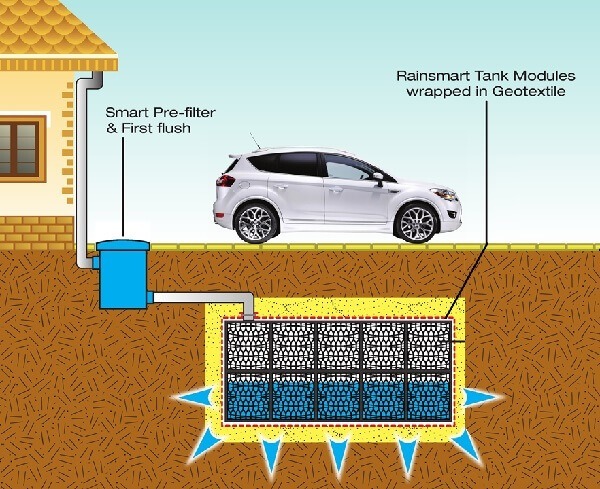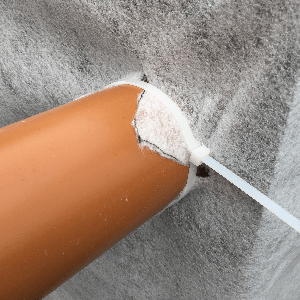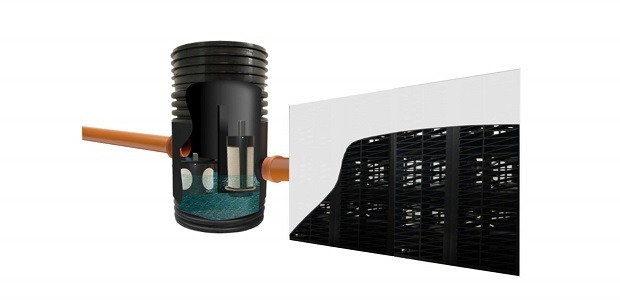Building Your Soakaway - Key Points
Once you have bought your soakaway crate, the real fun starts. It's time to begin the installation.
Choosing the location
 On new build projects and extensions, the site location should be marked on the plans. If you are adding a soakaway to an existing property, make sure it is at least 5 metres away from your property. If the site slopes back towards your property then go further away, as you don't want to risk undermining any of your foundation walls.
On new build projects and extensions, the site location should be marked on the plans. If you are adding a soakaway to an existing property, make sure it is at least 5 metres away from your property. If the site slopes back towards your property then go further away, as you don't want to risk undermining any of your foundation walls.
Always choose an area that you know is free from underground services - electric cables, gas or water mains, comms cables, existing drains or street lighting cables. If you are in any doubt, obtain site plans first from your local authority. Mistakes can costly and at worst, fatal.
If you are unsure as to whether your soil is suitable for a soakaway, check first with your local planning officer. You can also carry out a soil percolation test which will help determine the rate of infiltration for your soil.
Excavating the site
Our standard Ellipse 1 Cubic Metre Soakaway Set measures 1430mm (L) x 800mm (W) x 860mm (D), but don't forget that your hole needs to be large enough to allow for the sand base, side fill and backfill.
This means that for the standard cube set, you'll need to dig a hole that is 1730mm long by 1100mm wide. The soakaway depth depends upon the location - if it's under the garden or patio etc. it only needs to be 1310mm deep, but if its under your driveway, your soakaway should be 1510mm deep to allow for a little more top fill.
If you don't want to dig that deep, check out our shallow soakaway options.
It's always easiest to use a mini digger to excavate the site, they are relatively cheap to hire, easy to use and will save you bags of time. If you do decide to dig out the site by hand however, please ensure that you take precautions. The HSE website is a good source of information for safe digging practices.
Preparing the soakaway base
Once the excavation has been completed, smooth out the base and remove any large stones, roots or flints. The next step is to introduce a 150mm layer of sharp sand for the crates to sit on. This should be compacted down and levelled out so that there are no undulations visible.
Installing the soakaway crates
If you are using our flat packed crates, now would be a good time to take a quick look at the assembly instruction video. It's a really simple process, each double crate takes around 2 minutes so to build 4 crates for a 1 cubic metre soakaway should take no more than 10 minutes.
All soakaway crates should always be wrapped in a non-woven geotextile membrane. This protects the soakaway by preventing any soil or sand particles from entering the crate structure, keeping the void clear for rainwater storage alone. If you skip this step, the efficiency of the soakaway will be severely compromised and its useful life will be short. Our cubic metre soakaway sets all include enough geotextile membrane to wrap all outward faces of the crate structure, including the base.
Some people prefer to wrap the crates first, but this makes clipping more difficult. We suggest laying out the membrane in a wide expanse across the hole (much as you would when installing a pond liner), then carefully lowering the crates down into the excavation. Pull them together using the cable ties (provided with our sets) trim and tape the geotextile around the crates, covering all outward faces including the pipe entry point.
Please note that the cable ties are not structural, they are only there to hold the crates together until the side fill has been introduced into the hole.

Making the pipe connection
Pipe entry points vary between crate manufacturers. Some have cut-outs or knock-outs, some don't provide entry points, in which case the pipe is butted up to the soakaway crate wall. Our Ellipse crates all include an open pipe entry plate on each crate allowing access for either 160mm or 110mm drainage pipes. If you are only bringing one pipe into the soakaway, turn the remaining crates so that the pipe entry plates face inwards into the soakaway as this will prevent the geotextile from sagging into the plates.
Offer the pipe up to the entry plate, draw a line around the pipe on the membrane and mark the centre point. Using a Stanley knife cut a cross in the membrane and carefully fold it back. Introduce the pipe into the crate, pushing it in approximately 150mm. Finally, fold the membrane down around the outside of the pipe and tape or cable tie it in place (our cubic metre sets all include a large cable tie for this purpose). Our soakaway pipe entry video shows this in more detail if you are unsure.
The pipe entry will be supported in position by the side fill when it is introduced. At that time if you really want to belt and brace it you can pour a small amount of mortar mix or patching concrete around the joint.
Backfilling
With the structure all now in place you can introduce the side fill. This should be a 150mm wide layer of compacted sand or shingle. The side fill is important as it protects the crate structure against any ground movement whilst improving water flow into the soakaway from the surrounding soil. Our Ellipse crates have an industry-leading lateral load capacity of 18 tonnes, so with the correct side fill in place, their structural stability will never be in doubt.
On top of the crates, the initial layer should be the same as the side fill - a 150mm layer of sand or gravel. This is then covered by a layer of normal soil backfill (removing any large stones). In garden applications a further 150mm of soil should be sufficient, in a driveway we would recommend a 300mm layer of soil above the sand/gravel layer. This completes the soakaway installation.
Pre-Filter

As an extra step to maintain the long life and efficiency of your soakaway, fit a pre-filter. Our silt traps are a chamber that incorporates a removable silt bucket made from a sturdy mesh inside a PVC frame. Install this filter inline into the 110mm drainage pipe that feeds into the soakaway. It will intercept mud, silt or dirt particles that are washed into the drain from the gutters, channel drains or land drains that are discharging into the soakaway.
Regular maintenance is quick and easy. Take off the cover, lift out and empty the silt bucket, give it a quick clean around the mesh sides and drop it back in place. The silt bucket even comes with a useful high handle attached, this saves you having to reach into the muddy water to lift it out.
If you need any further information there is plenty more information in our Guides and Tips.



